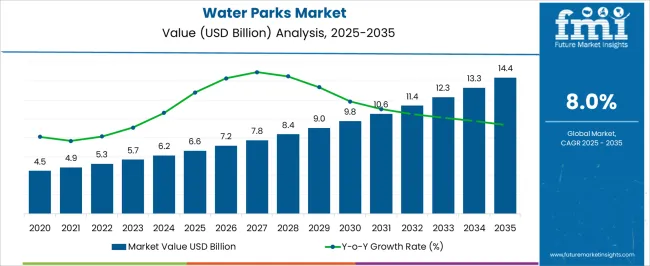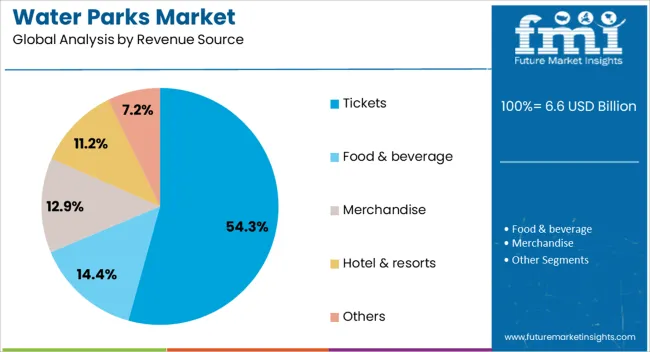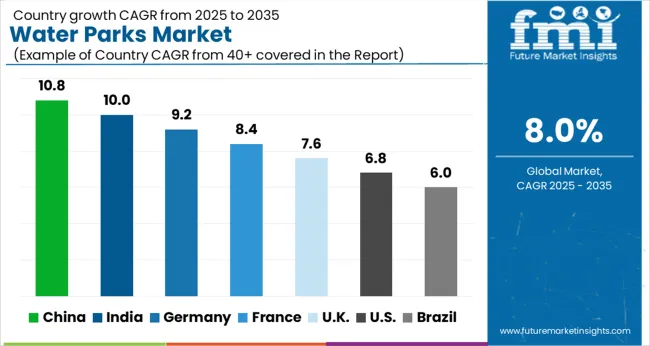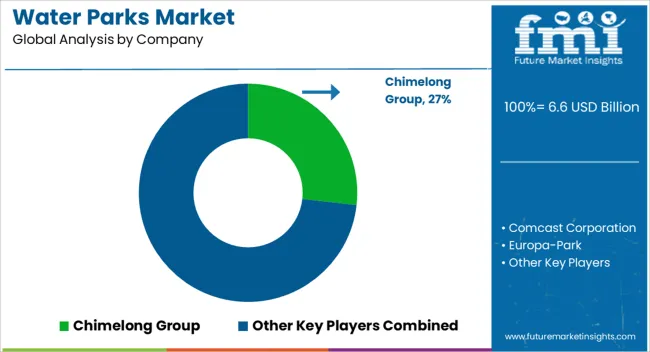The Water Parks Market is estimated to be valued at USD 6.6 billion in 2025 and is projected to reach USD 14.4 billion by 2035, registering a compound annual growth rate (CAGR) of 8.0% over the forecast period.
Between 2025 and 2030, expansion is expected to be led by emerging economies where large-scale entertainment complexes are being built to attract regional visitors. In developed markets, investment will be focused on modernizing existing parks with themed attractions, safety upgrades, and digital ticketing systems.
From 2030 to 2035, the industry is likely to see accelerated revenue generation as destination tourism integrates water parks with resorts, shopping centers, and hospitality services. The absolute growth of USD 7.8 billion over ten years underscores the widening appeal of themed entertainment, supported by strong participation from both domestic and international tourists.
Operators will prioritize customer experience, water conservation technologies, and diversified revenue streams through the sale of food, beverages, and merchandise. With Asia, the Middle East, and North America emerging as key growth hubs, the sector is poised to be a vibrant contributor to the broader leisure and entertainment economy.

| Metric | Value |
|---|---|
| Water Parks Market Estimated Value in (2025 E) | USD 6.6 billion |
| Water Parks Market Forecast Value in (2035 F) | USD 14.4 billion |
| Forecast CAGR (2025 to 2035) | 8.0% |
The water parks market is experiencing notable growth driven by rising disposable income, urban lifestyle expansion, and increasing demand for leisure and recreational experiences. A growing preference for short duration getaways and family oriented outdoor activities has elevated footfall in both standalone and resort integrated water parks.
Urbanization and tourism development projects have encouraged infrastructure investments, while climate conditions in tropical and warm regions continue to support year round operation. Technological innovations in ride safety, theme integration, and water conservation systems have further enhanced park appeal.
Additionally, operators are focusing on immersive and age inclusive attractions to maximize visitor engagement and repeat visits. The outlook remains positive as water parks evolve into multifaceted entertainment destinations catering to a broad demographic spectrum.
The water parks market is segmented by attraction type, age group, revenue source, and geographic regions. By attraction type, the water parks market is divided into Water slides, Lazy rivers and wave pools, Splash pads, and Cabanas and relaxation areas. In terms of age group, the water parks market is classified into the following categories: Up to 18 years, 19–35 years, 36–50 years, 51–65 years, and Above 65 years.
Based on revenue source, the water parks market is segmented into Tickets, food and beverage, Merchandise, hotel and resorts, and Others. Regionally, the water parks industry is classified into North America, Latin America, Western Europe, Eastern Europe, Balkan & Baltic Countries, Russia & Belarus, Central Asia, East Asia, South Asia & Pacific, and the Middle East & Africa.

The water slides segment is anticipated to contribute 47.60% of total market revenue by 2025 within the attraction type category, positioning it as the dominant segment. This growth is supported by strong visitor interest in thrill-based experiences and multi-rider interactive attractions.
Water slides offer a wide range of formats, including body slides, tube slides, and raft rides, catering to diverse age groups and adventure levels. Park operators continue to invest in innovative slide designs with integrated lighting, sound, and augmented reality elements to enhance excitement and differentiation.
High throughput capacity and lower maintenance costs compared to complex water shows or mechanical rides also contribute to operational efficiency. These combined advantages have reinforced the leading position of water slides in driving both attendance and customer satisfaction.

The up to 18-year age group is projected to generate 42.90% of market revenue by 2025, making it the most prominent demographic segment. This dominance is attributed to the strong demand from children, adolescents, and families seeking safe, engaging, and socially enriching experiences.
Water parks are increasingly designing youth-focused zones with shallow pools, interactive splash pads, and mini versions of larger rides to ensure inclusivity. Seasonal school vacations, birthday outings, and educational group visits have further increased attendance in this segment.
Operators also leverage character-themed environments and gamified attractions to boost engagement and encourage repeat visits among younger visitors. This sustained demand from the up to 18 years demographic continues to shape park design and marketing strategies.

The tickets segment is expected to contribute 54.30% of the total market revenue by 2025 under the revenue source category, maintaining its position as the primary income generator. This is driven by strong footfall in both domestic and international tourist destinations, with daily passes, group packages, and seasonal membership models offering flexible access.
Dynamic pricing strategies based on peak periods and online booking systems have optimized ticket revenue generation. In addition, promotional tie-ups with hospitality and travel companies have expanded reach and improved conversion rates.
While secondary revenue streams such as food, merchandise, and rentals are growing, tickets remain the backbone of water park profitability due to their consistent and predictable contribution to daily revenue cycles.
The water parks market is driven by rising consumer demand for immersive entertainment, investments in infrastructure, and regional expansions. As preferences evolve, water parks continue to innovate their offerings to meet diverse consumer needs.
The water parks market is propelled by an increasing demand for unique family entertainment experiences. As consumer preferences shift towards more immersive leisure activities, water parks have become popular destinations for families and groups seeking fun and relaxation. The appeal of water-based rides, wave pools, and water slides is growing, with investments in diverse attractions and premium offerings driving market growth. Expansion into emerging markets such as Asia-Pacific, where rising disposable income and tourism growth contribute to demand, is also supporting the market's upward trajectory. In established markets like North America and Europe, water parks continue to attract visitors with seasonal offerings and year-round entertainment.
Continued investment in state-of-the-art infrastructure is a key factor boosting the water parks market. Developers and operators are increasingly upgrading their facilities to offer unique and exciting attractions, such as themed water parks, water-based shows, and adventure zones. Enhancements in park designs focus on offering both relaxation and thrill experiences, catering to diverse consumer needs. The addition of high-end amenities like luxury resorts, fine dining, and premium experiences has made water parks more attractive to high-income visitors. As competition intensifies, operators are differentiating their offerings with signature attractions, ensuring they remain relevant in the rapidly growing entertainment landscape.
Water parks are expanding their reach in both developed and emerging markets. In North America and Europe, established markets continue to dominate the water park industry, attracting millions of visitors each year. However, regions like the Middle East and Asia-Pacific are increasingly becoming focal points for growth. With governments and private investors recognizing the demand for recreational attractions, they are building new water parks and investing in existing ones. Rising tourism and growing consumer interest in outdoor leisure activities are spurring rapid market development in these regions. Additionally, water parks are strategically located in tourist hubs to capitalize on the influx of international travelers.
Consumer preferences are shifting towards unique, immersive experiences in water parks, pushing operators to innovate continuously. Visitors are seeking more personalized, enjoyable experiences that go beyond traditional water rides. This has led to the introduction of themed attractions, interactive water-based activities, and wellness-focused offerings, such as spas and relaxation areas. Water parks are also incorporating modern safety features to ensure guest comfort and security. With increasing interest in health and wellness tourism, parks are integrating fitness-oriented experiences like water aerobics and sports activities. As consumer expectations evolve, the water parks industry is embracing these changes to remain competitive in a dynamic market.

| Countries | CAGR |
|---|---|
| China | 10.8% |
| India | 10.0% |
| Germany | 9.2% |
| France | 8.4% |
| UK | 7.6% |
| USA | 6.8% |
| Brazil | 6.0% |
The global water parks market is projected to grow at a CAGR of 8.0% from 2025 to 2035, supported by an increasing demand for leisure and family-oriented entertainment experiences. China leads with a CAGR of 10.8%, driven by growing disposable income, urbanization, and increasing tourism. India follows at 10.0%, benefiting from a rising middle class, greater leisure spending, and the expansion of water parks in key tourist destinations. France achieves 8.4%, supported by a mature market with consistent visitor influx and investments in infrastructure. The UK experiences a 7.6% growth rate, driven by strong tourism and demand for diverse recreational experiences. The USA maintains a 6.8% CAGR, reflecting stable market growth due to the high number of water parks and strong consumer interest in water-based leisure activities. The report offers insights into over 40 countries, providing a comprehensive analysis of regional market dynamics, drivers, and growth factors contributing to the global expansion of the water parks industry.
The water parks market in the UK is projected to grow at a CAGR of 7.6% from 2025 to 2035, slightly below the global average of 8.0%. Between 2020 and 2024, the market expanded at an approximate CAGR of 6.2%. This slower growth was due to market saturation in major cities, the impact of the pandemic, and increasing competition from alternative forms of leisure entertainment, such as theme parks and virtual experiences. However, post-2024, the market is expected to experience a rise in growth due to the increased investment in water park infrastructure, tourism-driven demand, and government efforts to boost recreational tourism. New attractions, enhanced visitor experiences, and the revival of international tourism are expected to accelerate market growth from 2025 onward.
China’s water parks market is expected to grow at a CAGR of 10.8% from 2025 to 2035, surpassing the global average of 8.0%. Between 2020 and 2024, the market expanded at a rate of 9.2%, supported by an expanding middle class, rising disposable income, and growing demand for leisure facilities in emerging urban regions. The rise of regional tourism in China and government investments in infrastructure also contributed to this growth. The robust growth post-2024 will be fueled by the country’s rapid urbanization, increasing interest in family-oriented leisure activities, and the continued development of world-class water parks, as well as the rise of eco-friendly park features to attract more visitors.
India's water parks market is projected to grow at a CAGR of 10.0% from 2025 to 2035, closely following China’s growth rate. The market expanded at a CAGR of 8.5% between 2020 and 2024, driven by rising urbanization, increased leisure spending, and the growth of tourism in popular states. The rise of the middle-class population, combined with a growing demand for family-oriented recreational activities, has resulted in the expansion of regional water parks, particularly in metros and tier-2 cities. From 2025 onward, India is expected to experience higher growth due to continued investment in water park infrastructure, new product offerings, and the development of niche experiences that appeal to a broad demographic.

France’s water parks market is expected to grow at a CAGR of 8.4% from 2025 to 2035, driven by increasing demand for family entertainment options and domestic tourism. Between 2020 and 2024, the market expanded at a rate of 7.0%, bolstered by stable demand from regional tourism and a strong interest in outdoor recreational activities. However, slow recovery post-pandemic, combined with competition from other leisure sectors, slightly dampened growth. Moving into 2025, France’s water parks are expected to experience revitalized growth, supported by new water attractions, thematic park offerings, and innovations focused on providing high-quality, sustainable experiences. The increasing trend towards experiential tourism is expected to boost the market.

The USA water parks market is projected to grow at a CAGR of 6.8% from 2025 to 2035, reflecting stable demand for leisure activities. Between 2020 and 2024, the market grew at a CAGR of 6.2%, driven by the popularity of water parks as family-friendly attractions, especially in warmer states like Florida and California. However, growth slowed somewhat due to increased competition, market saturation in some regions, and the economic impact of the pandemic on tourism and disposable income. Moving into 2025, the market will benefit from ongoing investments in water park upgrades, new ride innovations, and the recovery of tourism post-pandemic. As more international visitors return, demand for water parks is expected to rise again.

A few key players dominate the water parks industry, each offering unique attractions and experiences. Chimelong Group is a major player in the water park sector, known for its large-scale parks in China that combine water attractions with animal-themed exhibits. Comcast Corporation, through its subsidiary Universal Parks & Resorts, operates a strong portfolio of water parks globally, leveraging its extensive entertainment offerings to drive visitor interest.
Europa-Park, one of the largest theme parks in Germany, is expanding its water park offerings, capitalizing on its strong brand and location. Fantawild Holdings Inc. has a growing presence in the Chinese market, providing immersive water park experiences in addition to its traditional theme park offerings. SeaWorld Parks & Entertainment remains a prominent name in North America, integrating water parks with marine-life exhibits and themed attractions.
Therme Erding in Germany is one of the largest thermal water parks, offering a mix of wellness experiences and water-based fun, which appeals to a wide range of visitors. Tropical Islands in Germany, known for its unique indoor water park, attracts visitors year-round with a tropical-themed environment.
Walt Disney World Resort in the USA continues to lead the global market, with its iconic water parks, such as Blizzard Beach and Typhoon Lagoon, offering exceptional experiences for families. Wet'n'Wild Water Parks, with locations across the USA and internationally, is renowned for its family-friendly water attractions and a strong brand presence.
Wild Wadi Waterpark in Dubai, UAE, is another major player, offering a mix of thrilling water rides and family-friendly attractions in the heart of a global tourism hub. Key strategies within the water parks market include focusing on innovation with new rides and attractions, providing immersive experiences, and expanding into emerging markets.
Companies are also investing in family-oriented services and health-related amenities to enhance the overall visitor experience. The future growth of this market will depend on increasing tourism, ongoing investments in infrastructure, and the development of more sustainable and eco-friendly water park solutions.
| Item | Value |
|---|---|
| Quantitative Units | USD 6.6 Billion |
| Attraction Type | Water slides, Lazy rivers and wave pools, Splash pads, and Cabanas and relaxation areas |
| Age Group | Up to 18 years, 19–35 years, 36–50 years, 51–65 years, and Above 65 years |
| Revenue Source | Tickets, Food & beverage, Merchandise, Hotel & resorts, and Others |
| Regions Covered | North America, Europe, Asia-Pacific, Latin America, Middle East & Africa |
| Country Covered | United States, Canada, Germany, France, United Kingdom, China, Japan, India, Brazil, South Africa |
| Key Companies Profiled | Chimelong Group, Comcast Corporation, Europa-Park, Fantawild Holdings Inc., SeaWorld Parks & Entertainment, Therme Erding, Erding, Tropical Islands, WALT DISNEY WORLD RESORT, Wet'n'Wild Water Parks, and Wild Wadi Waterpark |
| Additional Attributes | Dollar sales, market share by region, and future growth projections, they would also look for an analysis of the competitive landscape, detailing key players, their market share, and product offerings. |
The global water parks market is estimated to be valued at USD 6.6 billion in 2025.
The market size for the water parks market is projected to reach USD 14.4 billion by 2035.
The water parks market is expected to grow at a 8.0% CAGR between 2025 and 2035.
The key product types in water parks market are water slides, lazy rivers and wave pools, splash pads and cabanas and relaxation areas.
In terms of age group, up to 18 years segment to command 42.9% share in the water parks market in 2025.






Our Research Products

The "Full Research Suite" delivers actionable market intel, deep dives on markets or technologies, so clients act faster, cut risk, and unlock growth.

The Leaderboard benchmarks and ranks top vendors, classifying them as Established Leaders, Leading Challengers, or Disruptors & Challengers.

Locates where complements amplify value and substitutes erode it, forecasting net impact by horizon

We deliver granular, decision-grade intel: market sizing, 5-year forecasts, pricing, adoption, usage, revenue, and operational KPIs—plus competitor tracking, regulation, and value chains—across 60 countries broadly.

Spot the shifts before they hit your P&L. We track inflection points, adoption curves, pricing moves, and ecosystem plays to show where demand is heading, why it is changing, and what to do next across high-growth markets and disruptive tech

Real-time reads of user behavior. We track shifting priorities, perceptions of today’s and next-gen services, and provider experience, then pace how fast tech moves from trial to adoption, blending buyer, consumer, and channel inputs with social signals (#WhySwitch, #UX).

Partner with our analyst team to build a custom report designed around your business priorities. From analysing market trends to assessing competitors or crafting bespoke datasets, we tailor insights to your needs.
Supplier Intelligence
Discovery & Profiling
Capacity & Footprint
Performance & Risk
Compliance & Governance
Commercial Readiness
Who Supplies Whom
Scorecards & Shortlists
Playbooks & Docs
Category Intelligence
Definition & Scope
Demand & Use Cases
Cost Drivers
Market Structure
Supply Chain Map
Trade & Policy
Operating Norms
Deliverables
Buyer Intelligence
Account Basics
Spend & Scope
Procurement Model
Vendor Requirements
Terms & Policies
Entry Strategy
Pain Points & Triggers
Outputs
Pricing Analysis
Benchmarks
Trends
Should-Cost
Indexation
Landed Cost
Commercial Terms
Deliverables
Brand Analysis
Positioning & Value Prop
Share & Presence
Customer Evidence
Go-to-Market
Digital & Reputation
Compliance & Trust
KPIs & Gaps
Outputs
Full Research Suite comprises of:
Market outlook & trends analysis
Interviews & case studies
Strategic recommendations
Vendor profiles & capabilities analysis
5-year forecasts
8 regions and 60+ country-level data splits
Market segment data splits
12 months of continuous data updates
DELIVERED AS:
PDF EXCEL ONLINE
Water Vapor Permeability Analyzers Market Size and Share Forecast Outlook 2025 to 2035
Water and Waste Water Treatment Chemical Market Size and Share Forecast Outlook 2025 to 2035
Water-cooled Walk-in Temperature & Humidity Chamber Market Size and Share Forecast Outlook 2025 to 2035
Waterless Bathing Solution Market Size and Share Forecast Outlook 2025 to 2035
Water Treatment System Market Size and Share Forecast Outlook 2025 to 2035
Waterborne UV Curable Resin Market Size and Share Forecast Outlook 2025 to 2035
Water Treatment Chemical Market Size and Share Forecast Outlook 2025 to 2035
Water Adventure Tourism Market Forecast and Outlook 2025 to 2035
Water Packaging Market Forecast and Outlook 2025 to 2035
Water Soluble Bag Market Size and Share Forecast Outlook 2025 to 2035
Water Leak Sensors Market Size and Share Forecast Outlook 2025 to 2035
Water-soluble Packaging Market Size and Share Forecast Outlook 2025 to 2035
Water Leak Detection System for Server Rooms and Data Centers Market Size and Share Forecast Outlook 2025 to 2035
Water and Wastewater Treatment Equipment Market Size and Share Forecast Outlook 2025 to 2035
Water Treatment Market Size and Share Forecast Outlook 2025 to 2035
Water Underfloor Heating Thermostat Market Size and Share Forecast Outlook 2025 to 2035
Water Activity Meter Market Size and Share Forecast Outlook 2025 to 2035
Water Leakage Tester Market Size and Share Forecast Outlook 2025 to 2035
Waterstops Market Size and Share Forecast Outlook 2025 to 2035
Water-miscible Metalworking Oil Market Size and Share Forecast Outlook 2025 to 2035

Thank you!
You will receive an email from our Business Development Manager. Please be sure to check your SPAM/JUNK folder too.
Chat With
MaRIA